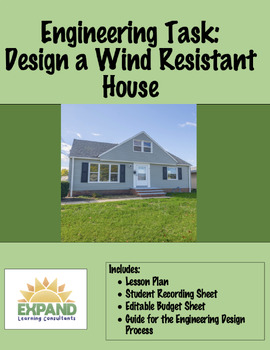Engineering Activity: Design a Wind Resistant House
Expand Learning Consultants
18 Followers
Grade Levels
K - 2nd
Subjects
Resource Type
Standards
NGSSK-2-ETS1-2
NGSSK-2-ETS1-1
NGSS2-PS1-1
NGSS2-PS1-2
Formats Included
- Word Document File
Pages
16 pages
Expand Learning Consultants
18 Followers
Description
Engage your students in an authentic engineering design activity. In this lesson, students use the science content taught to create a wind resistant house just like the three little pigs. Using simple, everyday materials, students apply the content of materials can be combined and do things that they cannot do by themselves to create and test prototypes.
This product includes:
· Teacher background information on the engineering design process
· Complete directions for lesson implementation
· Engineering Planning Sheet for students
· Editable Budget Sheet
Bonus: This can be used as a summative assessment for the unit.
Total Pages
16 pages
Answer Key
Does not apply
Teaching Duration
2 days
Report this resource to TPT
Reported resources will be reviewed by our team. Report this resource to let us know if this resource violates TPT’s content guidelines.
Standards
to see state-specific standards (only available in the US).
NGSSK-2-ETS1-2
Develop a simple sketch, drawing, or physical model to illustrate how the shape of an object helps it function as needed to solve a given problem.
NGSSK-2-ETS1-1
Ask questions, make observations, and gather information about a situation people want to change to define a simple problem that can be solved through the development of a new or improved object or tool.
NGSS2-PS1-1
Plan and conduct an investigation to describe and classify different kinds of materials by their observable properties. Observations could include color, texture, hardness, and flexibility. Patterns could include the similar properties that different materials share.
NGSS2-PS1-2
Analyze data obtained from testing different materials to determine which materials have the properties that are best suited for an intended purpose. Examples of properties could include, strength, flexibility, hardness, texture, and absorbency. Assessment of quantitative measurements is limited to length.


